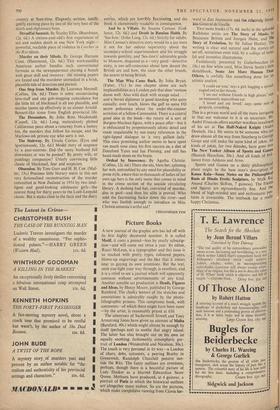Picture Books
A-NEW journal of the graphic arts has led off with its first highly decorated number. It is called Motif, it costs a pound-less by yearly subscrip- tion-and will come out twice a year. Its editor, Ruari McLean, is a typographer and this issue is so stacked with pretty types, coloured papers, blown-up engravings and the like that it comes near to guying its own intentions. But the text, once you fight your way through, is excellent, and it is a relief to see a journal which will apparently continue without advertisements of any kind. Another notable art production is Heads, Figures and Ideas, by Henry Moore, published by. George Rainbird. The chalky texture of the sketches and annotations is admirably caught by the photo- lithographic process. This sumptuous book, with comments-of which there might have been more -by the artist, is reasonably priced at £10.
The attentions of Sacheverell Sitwell and Tony Armstrong Jones have given an account of Malta (Batsford, 40s.) which might almost be enough by itself (perhaps not) to soothe that angry island. The latter has also brought out on his own an equally soothing, fashionably atmospheric por- trait of London (Weidenfeld and Nicolson, 30s.). The touch is very personal in its way-a London of chars, debs, tattooists, a peering Bratby in Greenwich, Randolph Churchill pensive out- side the Ritz. The fuzzy outlines are overdone, perhaps, though there is a beautiful picture of Lady Docker as a blurred Edwardian Snow Queen. Methuen have produced, at 4 guineas, a portrait of Paris in which the historical outlines are altogether more violent. So are the pictures, which make compulsive viewing from Clovis for- ward to Zizi Jeanmaire and the relatively blood. less General de Gaulle.
Two more books (17s. 6d. each) in the splendid Rathbone series are The Story of Music, by Benjamin Britten and Imogen Hoist, and The Story of Evolution, by Sir Julian Huxley. The writing is clear and natural and the stories are set off, sometimes even told, by a collage of taste- ful and inventive illustrations.
Fastidiously presented by Gaberbocchus (at 18s.) on fine white card, Miss Stevie Smith's little sketchbook, Some Are More Human Than Others, is awfully like something done for all artistic analyst.
'I could eat you,' says a girl, hugging a spread' eagled owl to her bosom.
'I am not without friends in high places,' saYs an immensely supercilious cat. '1 loved and am loved,' -says some sort of gargoyle, crouching.
This is a private world and all the more intriguing in that our welcome to it is so uncertain. Mr. Andrd Francois offers another wordless instalment of his art in The Half-Naked Knight (Anclr Deutsch, 16s.). He seems to be someone who can draw almost all the way from Steinberg to George Grosz and still make the same kind of jokes. All kinds of jokes, for two decades, have gone into The New Yorker Album of Sports and Games (Hamish Hamilton, 30s.). And all kinds of bril- liance from Addams and Arno.
Sports and Games on a dizzy .philosophical
plane might be the base man's description of Kama Kala-Some Notes on the Philosophic°l, Basis of Hindu Erotic Sculpture, by Mulk Rat Anand (Charles Skilton, 7 guineas). The friezes and figures are extraordinarily fine. And the blend of high-minded text and enthusiastic Pais- tures is irresistible. The textbook for a really happy Christmas.














































































 Previous page
Previous page